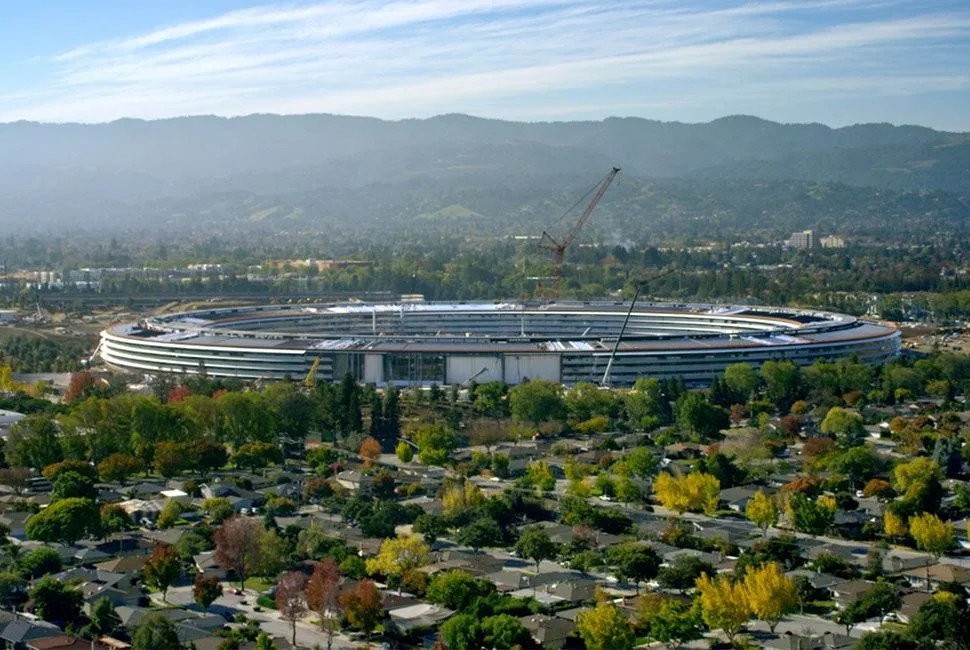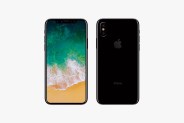There’s a new building in Silicon Valley — Apple’s shiny, circular corporate headquarters. It’s a massive bit of Norman Foster–designed office space that will house 14,000 employees. There will be a fitness center, an auditorium, seven cafeterias, underground parking, and miles of walking and cycling trails on the building’s campus (of which 80 percent will be green space). The structure consists largely of glass, concrete and metal, constructed with painstaking precision for a clean, seamless look from top to bottom. On the surface, it’s all innocent — cool new digs for a cool company. But if the medium is the message, what are we to infer from this perfect infinite loop?
Architecture is a funny thing. Office buildings designed in the Brutalist model, for instance — which was hugely popular between the 1950s and 1970s — can be models of economy, efficiency, and seriousness of purpose; or, they can be grim and oppressive, boring and lifeless. When the pendulum swings the other way, to the kind of bright, artfully angular designs exemplified by the Getty Center in Los Angeles, some see inspiring environments that “elevate the soul” while others see wildly confusing layouts, unnecesary design flourishes and hints of manipulation bordering on mind control.
While we don’t know yet what the interior spaces of Apple Park will be like, there’s much to mull from outward appearances. Writing in The Atlantic, Ian Bogost used the new circle in Cupertino — initiated in 2009 by Steve Jobs, now a slowly fading ghost in Cupertino — as a springboard for arguing that Apple’s long-vaunted design work is not only skin deep, but also somewhat fascist. To him, it represents the dictatorial vision of its creator rather than any real insights into a properly functional workspace. I wouldn’t go quite that far, but Apple Park does have a distinctly Janusian gestalt going that echoes a building that could be its spiritual predecessor: the Pentagon.
While we don’t know yet what the interior spaces of Apple Park will be like, there’s much to mull from outward appearances.
Both buildings are massive, yet low. They’re impressive, but woven into the fabric of the landscape without dominating it. From the street, you can hardly see either structure, but you sense they’re there. (That’s precisely what Jobs would want, of course.) The buildings take up similar space, though the Pentagon crams nearly triple the usable square footage into its footprint, and it benefits more from its unique geometry when it comes to moving personnel around. Its pentagonal design famously lets you reach any part of the building in just seven minutes, often by crossing the center courtyard. Apple Park may be able to benefit from similar short-cutting, though its interior courtyard is far larger and seemingly absent of any straight-line sidewalks. (Perhaps there are tunnels?) It’s precisely what you’d get if you hired a bunch of surfers, yogis and creatives to redesign the Pentagon — a far less efficient, but far prettier, product. A symbolic shape, but not a functional one.
Both buildings also project dueling messages. The Pentagon is both a fortress in strength, with its cliff-like façade, and an ode to democratic ideals, with its concentric rings implying a degree of transparency. One could look at the circular structure in Apple Park and see elegant symbolism from a company that strives to unite the world through technology — or you could see circled wagons, an exclusionary environment that’s not transparent despite all that glass.
The Pentagon was built during a time of great national anxiety. Its completion was accelerated because of Pearl Harbor — and racial segregation. President Franklin Roosevelt, while inspecting the structure, ordered the removal of “whites only” signs from the bathrooms. Meanwhile, Apple’s HQ arrives at a time when the matters of economic equality and diversity weigh heavily on us, and the company still represents a solidly white-male industry. (Its leadership is around 70 percent that demo, and diversity overall isn’t great.) Its circular shape also hints at the hoarding of wealth. Apple, after all, has vast cash holdings totaling $230 billion.

